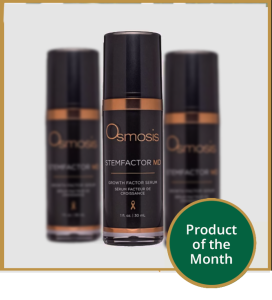Acne affects most people, usually during their teenage years. Some types of acne are severe and take a long time to heal. They are called cysts and nodules and may leave scarring.
In this article, we explain the main types of acne scars, how they form, and how to treat them.

5 Types of Acne Scars
Types of acne scars differ depending on the type of acne that caused them and how they were treated. Popping and squeezing acne increases the chance of scars developing.
When acne scars are flat or in the form of depressions of varied sizes beneath the skin, they are called atrophic. They are categorized into icepick, rolling, and boxcar scars.
Raised lumps on the skin are either hypertrophic or keloid scars.
1. Icepick Acne Scars (Atrophic)
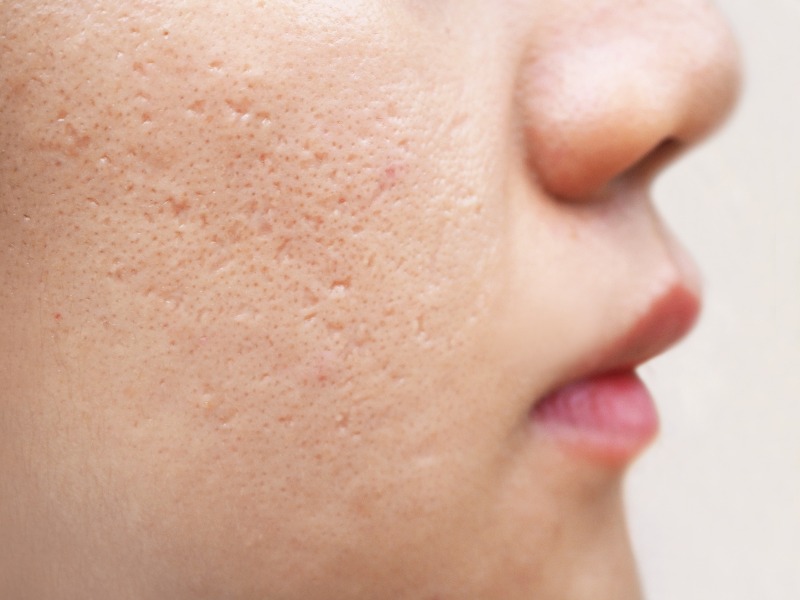
Icepick acne scars are small and deep-set, with rigid edges, and look like the skin was broken by an icepick – hence, the name. Icepick scars are usually the size of the acne that caused them. They appear on the cheeks and the jawline.
How Do Icepick Scars Develop?
Icepick scars form after very inflamed cystic or nodular acne damage the cellular walls deep in the dermal layers. If you don't treat severe acne properly, and if the body produces too little collagen to fight skin inflammation, an atrophic scar develops.
Icepick Scars Treatments
Icepick scars are the most severe type of acne scars. The treatment involves removing damaged skin, filling up the scar pit with collagen, and treating any discolored skin left by the scar. Skin discoloration is usually addressed separately during the second stage of the treatment.
The most effective treatments for icepick scars are as follows:
- Chemical peels are cosmetic procedures that entail the use of chemicals to peel off damaged skin layers. TCA and CROSS techniques are the most effective chemical peels for icepick scars. They involve the use of different concentrations of Trichloroacetic acid (TCA) to destroy damaged skin layers and then fill up the depressed scar with collagen.
- Fractional photothermolysis is a laser treatment that creates small wounds in dermal layers, stimulating the skin to produce collagen.
- Punch excision is a surgical procedure that removes the scar by creating a punch that is slightly bigger than the acne scar. The linear closure that remains after the scar ideally fades with time.
- Punch replacement grafting is like the punch excision procedure, except the icepick scar is replaced with a skin graft that heals at the skin’s surface level or is slightly elevated.
- Microneedling is a method of puncturing the skin using a device with many tiny needles, stimulating collagen production in the process. The new collagen smooths out the scarred skin.
The most effective second-stage skin discoloration treatments are:
- Chemical peels
- Laser therapy
- Microneedling
Note: Learn how microneedling for acne scars works and what to expect.
2. Rolling Acne Scars (Atrophic)
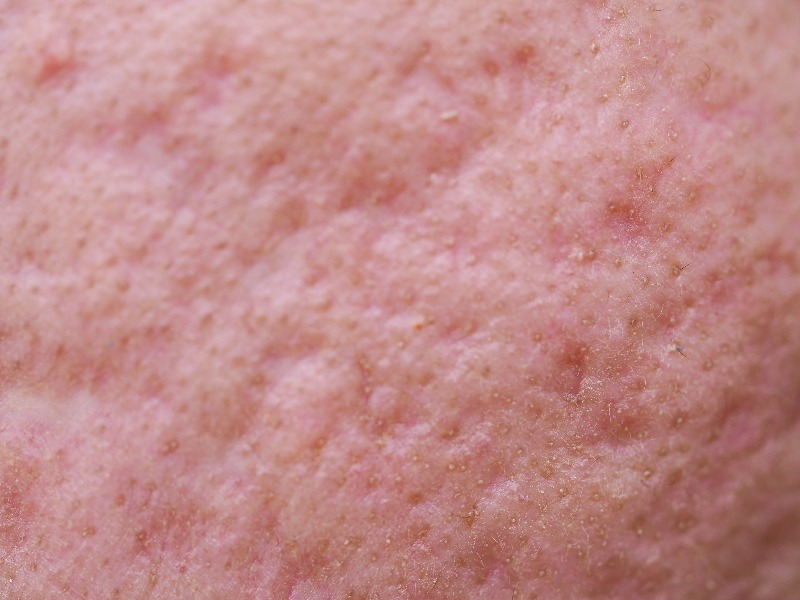
Rolling acne scars are a type of atrophic scars that have a wave-like texture on the skin. They are wider than icepick scars, usually with sloping edges. They appear on the cheeks or jawline.
How Do Rolling Scars Develop?
Rolling scars form as severe acne heal. Like icepick acne scars, they develop due to untimely acne treatment and loss of collagen. Picking at acne may also cause rolling scars.
Rolling Scars Treatments
Rolling scars may require several treatments. The most effective procedures for this type of treatment are as follows:
- Microneedling
- Fractional photothermolysis – A novel, non-ablative type of laser treatment where the laser produces microscopic thermal wounds without injuring surrounding tissue.
- Laser resurfacing – A dermal heating method that creates tiny wounds in dermal layers, resulting in collagen and tissue remodeling.
- Tissue augmentation techniques – Procedures that use soft-tissue fillers injected under scars. Dermal fillers are commonly used soft-tissue filler injectables for rolling scars.
- Subcision – A surgical procedure where a needle is punctured into the skin to make small cuts and remove the scar from the connective tissue and make it level with the rest of the skin. After the subcision procedure, the patient usually requires a stage-two treatment for skin discoloration.
3. Boxcar Acne Scars (Atrophic)
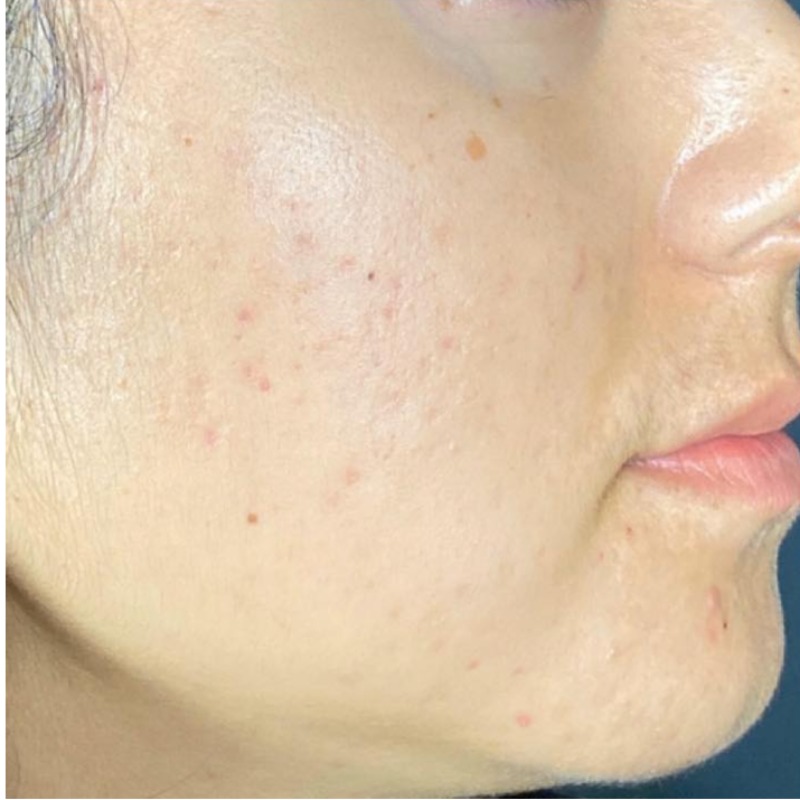
Boxcar acne scars are shallow depressions with well-defined edges, often resembling a square or a box. They usually appear on the cheeks, jaw, and temples.
How Do Boxcar Scars Develop?
Boxcar scars are most commonly the result of untreated cystic or nodular acne. Like other atrophic acne scars, boxcar scars form when the body produces less collagen than needed to heal scars.
Boxcar Scar Treatments
The most effective boxcar scar treatments are:
- TCA and CROSS technique chemical peels
- Laser resurfacing
- Fractional photothermolysis
- Microneedling
- Microdermabrasion – A procedure during which dead skin cells are removed using tiny crystals that sandpaper the top skin layer, stimulating collagen production.
- Punch elevation – A surgical procedure where the bottom of the scar is removed and reattached to the scar sides to smooth the skin.
Note: Read our article microdermabrasion vs. microneedling to learn about their differences and similarities and how they may help with your acne scars.
4. Keloid Acne Scars
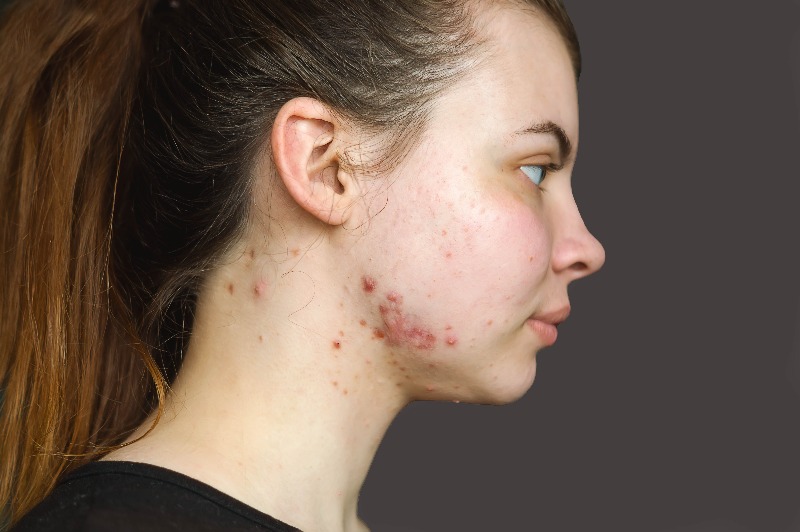
Keloid scars are red, lumpy scars on the surface of the skin. They usually appear on the jawline, chest, shoulders, neck, and back.
How Do Keloid Scars Develop?
Keloid scars appear when the body produces excess collagen in an attempt to heal an acne breakout. The overproduction of collagen causes thick tissue to grow on the skin, making the scar bigger than the acne. Darker-skinned people are more prone to keloid scars.
Keloid Scars Treatments
There are no fully effective treatments for keloid acne scars, but some procedures can reduce their size and minimize their appearance. The most common keloid scar treatments are as follows:
- Steroid injections – Shots of a corticosteroid medicine injected into the scar tissue. Several injections are needed at four-to-six-week intervals.
- Cryotherapy – A method of freezing the keloid scar to reduce its appearance. The treatment may be combined with steroid injections to make them more effective.
- Laser therapy – Shrinks the keloid scar and is frequently combined with steroid injection treatments.
5. Hypertrophic Acne Scars
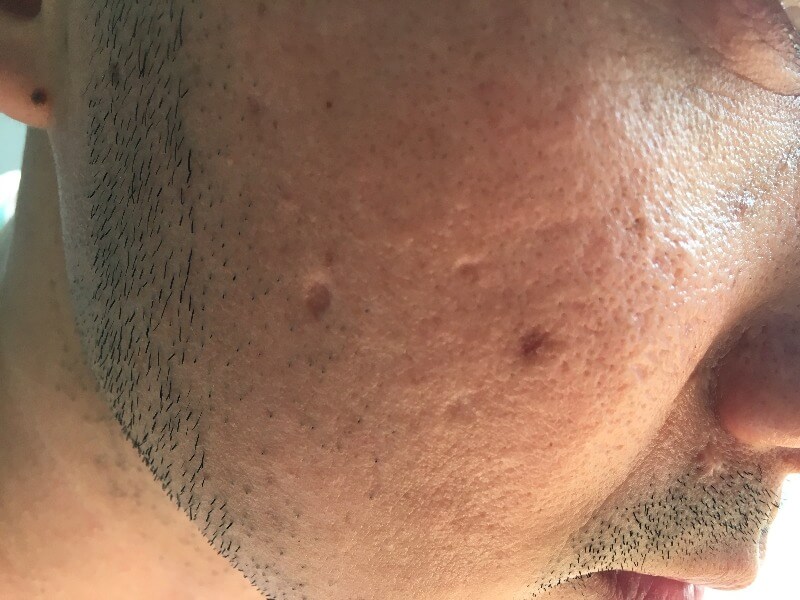
Hypertrophic acne scars are red or pink raised lumps on the skin that form after acne heals. Unlike keloid scars, they are the same size as acne and may grow smaller and fade with time.
How Do Hypertrophic Scars Develop?
Like keloid scars, hypertrophic acne scars form as the body overproduces collagen during the healing process.
Hypertrophic Scars Treatments
Hypertrophic scars are treated with:
- Steroid injections
- Laser therapy
- Cryotherapy
- Silicone gel sheeting – Silicon sheets are applied on the scar tissue for six to 12 months to reduce their size and soften them.
Can Acne Scars Heal 100%?
Acne scars are permanent and, in most cases, can’t heal completely. Minor scars may fade naturally with time, while deep and severe acne scars require more intense cosmetic treatments and medications. The effectiveness of the treatment depends on the severity of the acne scars and the treatment type.
In most cases, treatments such as laser therapy, microneedling, and steroid injections help fade or eliminate acne scars to the point that they are barely noticeable. The wrong therapy can worsen acne scars, so it is essential to find a reputable medical provider for the treatment.
What Acne Scar Is the Easiest to Treat?
Rolling atrophic scars are softer and more shallow than other scar types. Because of this, they generally respond well to treatments and are the easiest to treat.
What Acne Scars Are the Most Difficult to Treat?
Icepick atrophic acne scars may be the most difficult to treat because they are the deepest. The treatment typically requires a combination approach and more time to achieve results.
Conclusion
Seek timely, professional advice on how to treat different types of acne. If you don't treat severe acne properly, you may develop acne scars. Some scars fade away with time, but others are permanent.
Luckily, different acne scar treatments are available. Their effectiveness depends on correctly identifying the type of acne scar.
If you are or know a teenager with acne problems, also check out our article on how to treat teenage acne.

